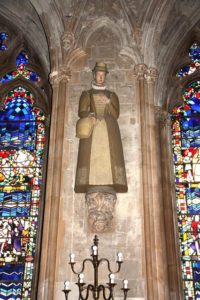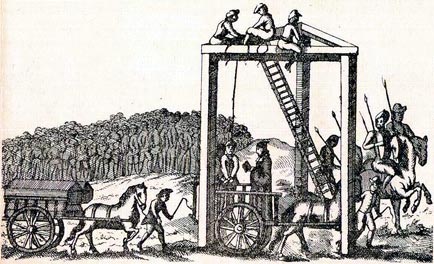 Margaret Ward was born in Congleton, Cheshire, in around 1550; however, this is an estimated guess as we know very little information regarding her early life.
Margaret Ward was born in Congleton, Cheshire, in around 1550; however, this is an estimated guess as we know very little information regarding her early life.
What we do know is that Margaret was living in London, working in the service of a lady, when she found out about the suffering of Richard Watson, a Catholic priest who was imprisoned at Bridewell Prison. She eventually obtained permission to visit him, and over the course of her visits, the guards became less cautious. This lack of caution enabled Margaret to formulate an escape plan for Watson. Margaret’s plan involved commissioning a boatman to take him to safety after he had escaped using some rope that she would provide.
Margaret then smuggled some rope into the prison, and Watson used it to climb down to freedom; however, things didn’t go quite to plan. As a result, Watson ended up hurting himself and left the rope dangling from the window, which was incriminating evidence. In addition to this blunder, the boatman Margaret had hired to get Watson to safety suddenly, on the day, refused to carry out his end of the deal, scuppering their planned escape. Margaret, therefore, had to think on her feet and, in a panic, asked another boatman named John Roche to help them. Luckily for Margaret, Roche agreed, provided them with a boat, and swapped clothes with Watson. Thanks to Margaret, Watson escaped successfully. Sadly, though, Roche was captured, and Margaret was implicated in the escape due to her frequent visits to see Watson in prison.
Margaret was eventually arrested and questioned on the whereabouts of Watson. She was kept in irons for eight days, hung up by her hands and whipped, yet still refused to reveal Watson’s location. At her trial, she admitted to helping Watson escape, stating that she was saving an innocent lamb from wolves. Margaret was offered a pardon in exchange for attending a Protestant service, but she refused. Margaret was hanged at Tyburn on 30th August 1588 alongside John Roche, Richard Leigh and Richard Flower.
Margaret was beatified in 1929 and eventually canonised by Pope Paul VI on 25th October 1970, becoming one of the 40 martyrs of England Wales. Margaret shares a feast day on 30th August with her fellow female martyrs Margaret Clitherow and Anne Line.
by Georgia Whitehead
Georgia has just finished her masters in Classics at the University of Edinburgh. Academically, Georgia is interested in early Christianity, with her master's thesis focusing on "The Male Gaze and Self-Representation in Female Christian Narratives". In addition to her interest in ancient history, she has always been an avid lover of the Tudor era, drawn to the magnificence of the Tudor courts and the larger than life characters. She is particularly interested in The Reformation, Christianity and the shifting sands of ecclesiastical politics in this period and also has a keen interest in the lives of Tudor women. It is Georgia's ambition to become a writer, perhaps publishing her own Tudor novel one day.
Georgia also runs a history blog and instagram page called Historia Mundis.
Photo: John Salmon / St Etheldreda, Ely Place, London EC1 - Nave statue of St Margaret Ward, Geograph.org.uk.



There is a seventeenth century convent in York dedicated to Margaret Ward. Its now a museum but there is a modern convent next to it dedicated to Saint Margaret Ward. Across Europe there was a movement dedicated to Margaret Ward in the eighteenth century. I have a huge tome of her prayers, meditations and writing.